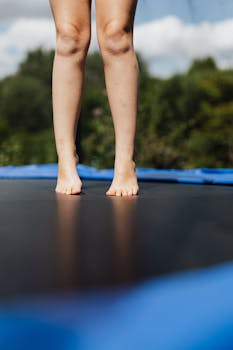Contact Us (720) 964-1335 or (901) 675-6125

Let’s be honest: jumping on a trampoline may not sound like a “serious” fitness strategy. But once you understand what a mini rebounder can do for your lymphatic system, hormones, and mental health, you’ll realize it’s one of the smartest low-impact tools out there. It’s fun, joint-friendly, and a surprisingly powerful wellness tool for women over 40.
As a certified holistic nutrition weight loss coach and nurse practitioner, I often recommend the Perform Better mini rebounder to clients who are rebuilding stamina, detoxifying gently, or easing into joyful movement, especially after a period of inactivity or while tapering off GLP-1 medications.
The Wellness Benefits of Rebounding
- Lymphatic Drainage: Bouncing helps clear toxins by stimulating lymph fluid flow, which boosts immunity, reduces swelling, and helps reduce bloating.
- Bone Strength: The mild impact stimulates bone-building activity (great for postmenopausal women managing osteopenia or osteoporosis).
- Mood & Mental Health Boost: Rebounding increases circulation and releases feel-good endorphins.
- Joint-Friendly Cardio: Unlike pavement pounding, mini rebounders provide cardio benefits without aggravating the knees, ankles, or hips.
- Blood Sugar Support: Frequent low-intensity movement helps regulate insulin response, which is essential for midlife metabolism.
🌀 Ready to bounce your way to better health? Click here to shop the Perform Better mini rebounder and energize your wellness journey.
Rebounding for Women Over 40: Where to Start
- 5-Minute Morning Reset: Light bouncing to wake up the lymph system and energize your body.
- Midday Metabolism Boost: Bounce for 10 minutes to combat sluggish afternoons.
- Evening Decompression: Gentle rebounding can replace emotional snacking or doom scrolling.
Suggested Beginner Routine:
- 1 minute light bounce
- 30 seconds side-to-side bounce
- 30 seconds knees-up bounce
- Repeat 3–4x with breaks as needed
Client Story: Bouncing Through Burnout
One of my clients, Tanya, was going through both hormone therapy and a GLP-1 adjustment phase. She felt depleted, discouraged, and disconnected from her body. High-impact workouts weren’t appealing but bouncing for 10 minutes a day? That felt manageable.
Within 2 weeks, she reported better sleep, less bloating, and more energy. She also felt emotionally lighter, something she hadn’t experienced with other workouts. This is what I call movement medicine. You’re not just working out. You’re working in.

